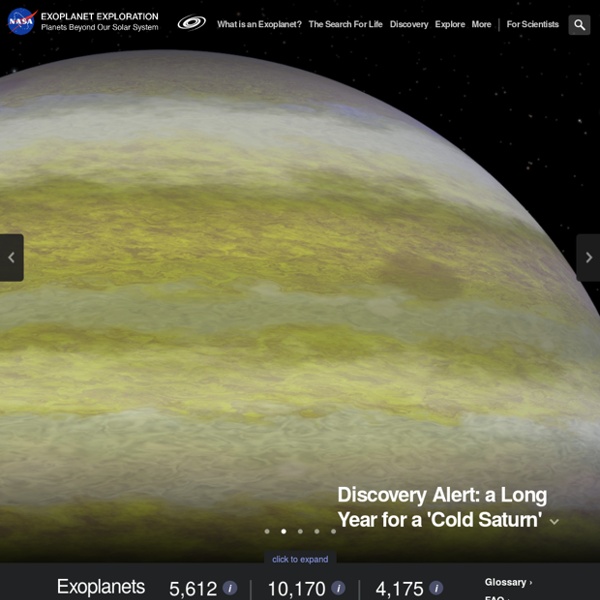



Tales of Future Past It wasn't that long ago that we had a future. I mean, we have one now; the world isn't going to crash into the Sun or anything like that. What I mean is that we had a future that we could clearly imagine. The future wasn't tomorrow, next week, next year, or next century. Alien Habitable Planets May Exist Billions of Years Older Than Earth Building a terrestrial planet requires raw materials that weren't available in the early history of the universe. The Big Bang filled space with hydrogen and helium. Chemical elements like silicon and oxygen - key components of rocks - had to be cooked up over time by stars. But how long did that take? How many of such heavy elements do you need to form planets? Previous studies have shown that Jupiter-sized gas giants tend to form around stars containing more heavy elements than the Sun.
ChronoZoom ChronoZoom is an educational tool for teachers and students who want to put historical events in perspective. A great many resources have been created already in ChronoZoom for your enjoyment and enlightenment. Start Exploring Exoplanets: Worlds Beyond Our Solar System Exoplanets are planets outside of the solar system. They are also referred to as extrasolar planets. Starting in 1992 with the first discovery, astronomers have located about 837 such planets in 660 planetary systems around the Milky Way galaxy. Researchers believe they will find many more planets — a 2012 study estimated that each star of the 100 billion or so in the Milky Way galaxy hosts on average at least 1.6 planets. GJ1214b, shown in this artist’s view, is a super-Earth orbiting a red dwarf star 40 light-years from Earth. New observations from the NASA/ESA Hubble Space Telescope show that it is a waterworld enshrouded by a thick, steamy atmosphere.
New Quasiparticles Found Scientists from the Weizmann Institute of Science in Israel have demonstrated, for the first time, the existence of quasiparticles with one quarter the charge of an electron. Quasiparticles are formed from the interactions of multi-particle systems, and act effectively as independent particles. Quasiparticles are known for having a fraction of the charge of an electron, but until now all the quasiparticles that were discovered had an odd denominator. The special attribute of an even denominator in the recently discovered quasiparticles may be the first step towards powerful and stable quantum computers.
Life...As We Don't Know It This article originally appeared in ReaClearScience's Newton Blog. You can read the original here. It's amusing and intellectually stimulating to seriously ponder the existence and characteristics of alien life. But like quantum mechanics, such contemplations can easily wrack the mind, leaving one quite discombobulated. I can only imagine the self-inflicted vexations suffered by astrobiologists, whose livelihoods require daily ruminations about life on inconceivably faraway worlds. Practical Physics This website is for teachers of physics in schools and colleges. It is a collection of experiments that demonstrate a wide range of physical concepts and processes. Some of the experiments can be used as starting-points for investigations or for enhancement activities. Many have links to carefully selected further reading and all include information and guidance for technicians. Physics is a practical science.
A planet is born: Astronomers capture 'super-Jupiter' challenging ideas about the formations of new worlds By Daily Mail Reporter Published: 21:49 GMT, 19 November 2012 | Updated: 07:55 GMT, 20 November 2012 A new planet labelled a 'super-Jupiter' has been spotted by astronomers who believe the find could challenge ideas about planet formations. Scientists have long debated the prospect of large stars given birth to planets in a rotating disk of dust and gas but the new find suggest this could now be true. Captured by Japan's Subaru 8-metre telescope the planet, thought to be 13 times larger than our solar system's biggest planet, Jupiter, the object was spotted orbiting a star called Kappa Andromedae.
Breakthrough in Thin-Film Solar Cells Scientists at Johannes Gutenberg University Mainz (JGU) in Germany have recently reported a breakthrough in their search for more efficient thin-film solar cells. Such cells could help create better solar receptors, improving both capacity and utilization of current devices – resulting in more realistically efficient sources for alternative energy. The new study shows that the new potential efficiency is 30%, a significant increase in comparison to contemporary cells that have only about 20% efficiency. Using computer simulations, the scientists investigated ways to improve the performance of CIGS thin-film solar cells; these are important since they are only a few micrometers thick, and offer savings on material and manufacturing costs.
How Incomprehensible Could Extraterrestrials Be? A few days ago Paul Gilster, the author of Centauri Dreams: Imagining and Planning Interstellar Exploration and the curator of Centauri Dreams , posted a thoughtful discussion of a blog entry I wrote (titled What's The Connection Between Deafness and SETI? ) His discussion and the resulting comments were fascinating, and in this post I want to carry on that conversation. I want to ask: Will extraterrestrials be so different from us as to be truly incomprehensible?
The Habitable Exoplanets Catalog - Planetary Habitability Laboratory The figure above shows all planets near the habitable zone (darker green shade is the conservative habitable zone and the lighter green shade is the optimistic habitable zone). Only those planets less than 10 Earth masses or 2.5 Earth radii are labeled. The different limits of the habitable zone are described in Kopparapu et al. (2014).